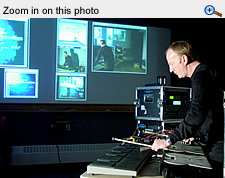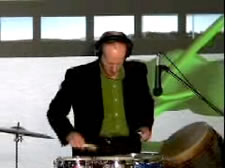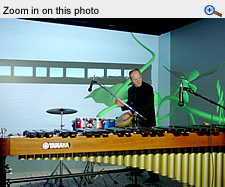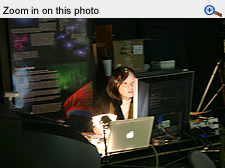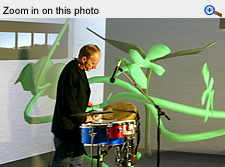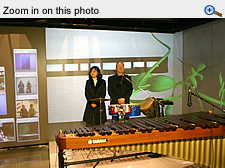Art on the Grid
By Jenn Wagaman, Arctic Region Supercomputing Center
August 2005
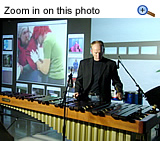 Deal plays the marimba during an Art on the Grid performance. His music was broadcast
to six sites where actors and dancers performed to the remote instrumentation.
Deal plays the marimba during an Art on the Grid performance. His music was broadcast
to six sites where actors and dancers performed to the remote instrumentation. The first time Assistant Art Professor Miho Aoki met Associate Music Professor Scott Deal she walked right in his office and said "I want to collaborate."
This assertiveness is a bit contrary to Aoki's artwork. Her work, much of which is created on computers, is subtle, displaying her sensitive and intuitive nature. But it's exactly this subtlety that makes her partnership with the innovative percussion professor unique and fitting.
Pushing the boundaries
The two have been collaborating for more than four years, joining forces with computer
specialists at the Arctic Region Supercomputing Center (ARSC) to use the newest technologies
to push the boundaries of their art and music.
Initially, Aoki created visuals for Deal's percussion pieces, and the two presented concerts that included digital drawings of Inupiaq dancers on a large screen behind Deal and his percussion instruments.
"When I started making visuals for Scott, they were like interpretive dancers without the bodies. Our collaboration worked because I agree with Scott's thinking--that visuals extend the physical presence of a piece--and in this project we were able to accomplish that," says Aoki. "Visuals also change the way people experience music."
Soon, the artists began to experiment using three-dimensional artwork, giving a concert in the ARSC Discovery Lab (a three-dimensional display environment) and eventually joining forces with participants of Art on the Grid, an experimental group of artists and computer scientists from around the country.
Now the two professors, along with students and researchers from across the UAF campus, are involved in the Art on the Grid project, which includes contributors from six states and artists and technical contributors from each site. The idea behind Art on the Grid is advanced, and describing it is, well, confusing.
High-tech interaction
Imagine a live dancer in front of a screen in Maryland. The music he dances to comes
from a live performer in Fairbanks. Meanwhile, an actor performs in front of a camera
in Utah. Her costumes are generated on a computer in Los Angeles and remotely follow
her around the screen, changing as the scene changes. Audiences at locations around
the world tune in to see these performances mixed together and re-broadcast live via
a high-speed network connection. This is Art on the Grid.
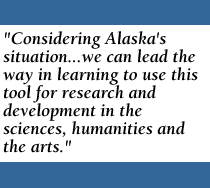 Art on the Grid is actually an off-shoot of a larger networking project called the
Access Grid, or simply, the Grid, that involves universities and research institutes
around the world. The Grid is an ensemble of resources including multimedia large-format
displays, presentation and interactive environments used to support group-to-group
interactions across the Grid network. Recognizing the importance of sophisticated
collaboration software to a remote university environment, researchers and students
at ARSC have been contributing to the Grid project for some time. With the help of
these students and researchers, Aoki and Deal were able to participate in the Art
on the Grid project using a complex blend of technology and provide their artistic
talents to collaboratively create an original work of art.
Art on the Grid is actually an off-shoot of a larger networking project called the
Access Grid, or simply, the Grid, that involves universities and research institutes
around the world. The Grid is an ensemble of resources including multimedia large-format
displays, presentation and interactive environments used to support group-to-group
interactions across the Grid network. Recognizing the importance of sophisticated
collaboration software to a remote university environment, researchers and students
at ARSC have been contributing to the Grid project for some time. With the help of
these students and researchers, Aoki and Deal were able to participate in the Art
on the Grid project using a complex blend of technology and provide their artistic
talents to collaboratively create an original work of art.
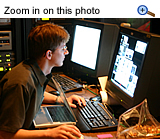 Computer science senior Eric Peterson focuses on operating the access grid node during
an Art on the Grid performance. As a student at the Arctic Region Supercomputing Center,
Peterson has worked to make grid technology more accessible by making the Grid software
available for Macintosh computers.
Computer science senior Eric Peterson focuses on operating the access grid node during
an Art on the Grid performance. As a student at the Arctic Region Supercomputing Center,
Peterson has worked to make grid technology more accessible by making the Grid software
available for Macintosh computers. Concerning the use of ultra-high speed Internet connections for projects, Deal said, "Considering Alaska's situation, geographically remote within itself and far from the rest of the nation, we can lead the way in learning to use this tool for research and development in the sciences, humanities and the arts. In this medium you can be anywhere and you can participate on your own merits. We have the opportunity to present a unique voice from our northern environment and contribute without the obstacle of distance."
Thus, the Art on the Grid collaborators continue to design pieces that can be performed and viewed around the world realistically and figuratively.
"These kinds of projects are compelling because of the conceptual enormity of the medium, which makes each event seem ubiquitous," said Deal. "Instead of a physical location that is somewhere, there is a web address that is everywhere. Anyone can venture there through their computer, and when they do, the minds and senses of real people, in real-time, are there also."
In the spring of 2005, Aoki, Deal and other Art on the Grid members completed their second performance and were invited to present it at the International Computer Graphics conference, SIGGRAPH 2005, this August in Los Angeles. The play, titled InterPlay: Loose Minds in a Box, is a multi-faceted telematic event that incorporates theater, text, music, performance art, virtual reality and motion capture that are concurrently captured, mixed, digitized, encoded and streamed onto a network. In August, Aoki will be in Los Angeles providing on-demand computer graphics while Deal will be performing in Fairbanks.
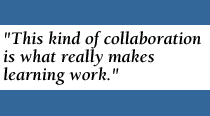 Access to technology at UAF
Access to technology at UAF
Aoki and Deal's work not only spans the globe, but also reaches into the classroom
at UAF. Students from the art, music and computer science departments are currently
contributing to the Art on the Grid project and mentoring at ARSC. Additionally, Aoki
teaches computer art, including animation and three-dimensional design, while Deal
leads the award-winning UAF percussion program.
"When energetic professors like Scott and Miho partner with UAF research institutes like ARSC, the result is a bridge between some of the world's most creative people and students who are active contributors as well as learners in these projects," said ARSC Director Frank Williams. "This kind of collaboration is what really makes learning work."
View the gallery of photos from Art on the Grid performance.
For more information, please contact:
- Jenn Wagaman, public affairs coordinator, Arctic Region Supercomputing Center, wagaman@arsc.edu or (907) 450-8662.
- Scott Deal, associate music professor, University of Alaska Fairbanks, ffwsd@uaf.edu or (907) 474-1873.
- Miho Aoki, assistant art professor, University of Alaska Fairbanks, ffma2@uaf.edu or (907) 474-5425.
Useful links:
- Access Grid
- Another Language: InterPlay
- Arctic Region Supercomputing Center
- UAF art department
- UAF music department
ARSC photos.
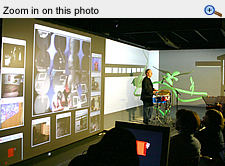
An audience observes the Art on the Grid performance from the ARSC Discovery Lab. At left, performers from the six participating sites around the country are shown on a large screen, while at right, Deal plays a percussion piece broadcast to the sites.
Deal plays the drums during an Art on the Grid performance.
InterPlay: Loose Minds in a Box
A video clip demonstrates the various aspects of the 2005 Art on the Grid event, InterPlay: Loose Minds in a Box. UAF's Deal and Aoki provided computer graphics and music for the multi-faceted event
that takes place simultaneously in six states across the country.
- Video for dialup (924MB)
- Video for broadband (1.6MB)
Deal played drums as well as marimba during the Art on the Grid performance.
Assistant Professor Miho Aoki concentrates on creating graphics during an Art on the Grid performance.
Deal plays the drums during an Art on the Grid performance. His music was broadcast to six sites where actors and dancers performed to the remote instrumentation.
Aoki, left, and Deal, right, take a bow following an Art on the Grid performance. To the left, window views of participants from other sites around the country show the other performers taking their bows as well.



